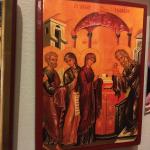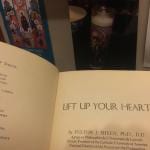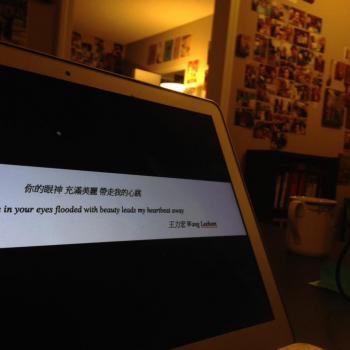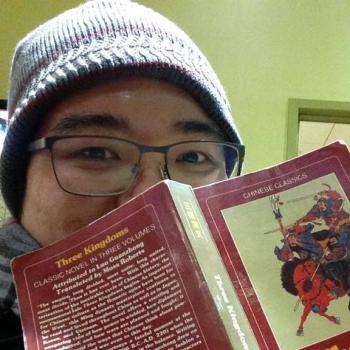
One of the graces of the Byzantine churches is our habit of echo-feasts. The Feast of the Encounter signals the end of the Nativity season, and that should be the end of it — no more Christ is born as a greeting, no more Christmas decorations, no more Nativity hymns at liturgy — and yet, as if to give us one really last time for a final bash, we have the echo-feast of the Holy and Righteous Symeon the God-receiver and the Holy Prophetess Anna right after the Meeting of the Lord, when he is presented by the Theotokos, herself the temple of the Lord who had been received into the temple, to the temple. As the calendar has it this year, the next day will be the Sunday of the Publican and the Pharisee, the first day of the Season of Preparation for the Great Fast, leading into a week where we are forbidden to fast, lest we become proud by our fasting and fail to join the tax collector in beating his breast and repeating the Jesus Prayer, Lord Jesus Christ, Son of God, have mercy on me, a sinner. We will do plenty of that in the Great Fast, especially when we fall down in prostration after prostration in the Great Canon of St Andrew of Crete on both the first and before the fifth weeks of the Fast. The first thing to excise from our praxis is pride itself.
It is as opportune a time as any to reflect on the prayer of the last few months. Over the course of the blog, I’ve written about how I carry the icon of the Nativity with me where I go and how practicing a Nativity spirituality that informs my politics. The prayer of the last several months has offered a time for more focused reflection, as our mission in Chicago has practiced reader’s services where we pray for social justice, as well as with the Great Feasts. As this Nativity season comes to a firm end and the movement from the Great Fast to Pascha and Pentecost begin, perhaps it is time to take stock of this movement from Christmas to Candlemas.
One of the things that I’ve realized over and over again in this church is that the declaration of intentions is overrated. Certainly, this is what one is told to do in a world of secularity, that a programmatic agenda for work and thought should be laid out and followed. In this way, I have been schooled in intention and am generally good at declaring what I am going to do. What I have learned in the spiritual life, though – which is the truest reality of a real life – is that intending to do something is not the same as doing it. In so doing, I have detected two conflicting movements in my life that began to manifest themselves in my catechumenate and now continue to conflict with each other, although as my spiritual father once told me, We are winning, in the sense that I am at least making effort, feeble as it is, to overcome life in the mode of pure intentionality. The second movement, I find, is the one that the mystagogy of our church affords, and it is that you might have a general idea of what you’ll get in a church service by reading the rubrics and the propers, but there is nothing quite like being thrown into the midst of it. The consolations — and the desolations too, when the person next to you is dominating the singing or when the liturgy is not being done quite right or the cantor takes the pitch way too high — cannot be anticipated. They suddenly come upon me, and the unexpected then itself becomes cause for reflection. In this way, practice precedes intention. It is not, I am learning, that intentions don’t matter, much as I used to say this to my friends when this double movement was overwhelming. It is more that my intentions are being shaped by reflection on my action. This, of course, is what most people in history have called praxis.
The reflection I have on the mystagogy of the last several months from St Philip’s Fast to this present Feast of the Encounter falls along these lines of praxis. I think my intention over this time was to reflect mystagogically on the concept that I’ve been trying to work through in my academic work – the postsecular – but it never really happened, except in my scholarly writing, which takes place off this blog. What I did come to last night as I was writing up my reflections for the Encounter, though – and this after writing an extremely tentative piece on the New Calendar celebration of the same feast – is how much the feasts and fasts of this first movement of the liturgical year draw our contemplations consistently back to the reality that we are first and foremost bodies. In the Encounter, the Theotokos – herself a temple who has entered the temple – brings the glory of the Lord into the temple in the frailty of his forty-day-old body. Together, they meet a prophet and a prophetess, Symeon and Anna, who have been dwelling bodily in the temple waiting for the fulfillment of the Lord’s promise. Symeon, upon seeing the Lord, asks to be dismissed from his body.
In this way, the movement of the fasts and feasts of this last season begin long before St Philip’s Fast, where the Holy Apostle Philip encounters an Ethiopian eunuch who has been mutilated in his body and joins him to the Body of Christ such that he shall never say again that he is a dry tree. With the Theotokos herself as a temple of the Holy Spirit, we are taken back all the way to the beginning of the church year, to her Nativity right after the Indiction. We begin with her as a body, and in that sense, as a temple in her own right. Indeed, the genius of the Ecumenical Patriarchate since 1989 has been to situate that meditation at the very beginning of the church year, at the Indiction, by naming it the World Day of Prayer for the Protection of Creation. We are bodies in the world. In the words of Patriarch Dimitrios in calling for the prayer that educates the faithful in ecological justice: ‘It constitutes a fundamental dogma of her faith that the world was created by God the Father, who is confessed in the Creed as being “the maker of heaven and earth and of all things visible and invisible.” According to the great Fathers of the Church, man is the prince of creation endowed with the privilege of freedom. Being simultaneously a partaker of the material and the spiritual world, he was created in order to refer creation back to the Creator so that the world may be saved from decay and death.’ In this way, the Ecumenical Patriarchate casts the first move of the liturgical year, from the Indiction to the Encounter, as an extended Vespers service, beginning with creation, descending into our sin, lighting the lamps, and announcing the Word of God in the evening. The point in turn is that the Nativity is literally about bodies being born into the world, and these feasts and fasts of this first movement show them to us as temples, first of the Godbearer and then of the God who is borne into the world.
I would not say that our church has a premium on reflection on the body. It may be strange to say this, but when I was an evangelical, there was plenty of reflection on bodies. As a teenager, I read Jerry Bridges’s Pursuit of Holiness, an evangelical classic associated with the group, the Navigators, where he speaks of the holiness of the body and the need to care for it as a temple of the Holy Spirit. I attended courses at Regent College, where speakers like Marva Dawn and Eugene Peterson, as well as most of the teaching faculty there (especially Loren Wilkinson), spoke of taking Sabbath and eating well and fasting because the body is what the Lord has created us to be. We read texts from the exegetes Joel Green and Walter Brueggemann that disputed the popular Christian notion that we are souls in bodies and that Scripture advocates for a monist version of existence, that all we have are bodies and that when we are raised from the dead as the Lord was as the firstfruits of the new creation, it will be to be in a resurrectional body. In this way, Metropolitan John (Zizioulas) of Pergamon, the great ecumenist of the Ecumenical Patriarchate, was very popular among many of us, especially his argument that we move from a biological mode of existence when we have an ecclesial dimension of existing because we are no longer living to survive, but alive with an orientation to the resurrection and therefore have nothing to fear from death.
What I am saying is that in this church, I do not need to be reminded of these concepts as ideas to focus on when I am part of the liturgy. The whole of this first liturgical movement in the first part of the year requires me to participate as a body in these somatic contemplations. I sing, I stand, I reverence, I prostrate, I read: these are all practices in competency that leave little time for overthinking. Acting in the body is not just a good idea, which it almost still is in John Paul II’s Theology of the Body, which only really explores the sexual dimension of bodily life — and that usually from a single man’s perspective who has never been married and therefore inhibits his reflection often to the realm of ideas and not of practice (for this reason, I much prefer Paul Evdokimov’s Sacrament of Love). Acting in the body is an act (and my sense is that this is where John Paul II’s thought really shines, not only in The Acting Person, but in his meditations on St John of the Cross), and the participation in the liturgy that draws us back in the temple to our bodies as temples requires the action of the body.
It is the groundedness in the body as temple that motivates my life in the world. I feel like I have been emboldened over the last few months to write about my scholarly work, as well as the small acts that I am taking in my community to work for social justice, explicitly foregrounding the womanist and ecological convictions that have also informed my sense of bodily life and why it is not killable. But that boldness does not come from ideology. It is not a set of ideas that are laced together with my intentions that allow me to keep writing, reflecting, and acting some more. It is acting itself in a sense of bodily competence and integrity, to practice first and reflect later. It turns out that the mothers and fathers of the church had this reflection before me, and they designed the services of the church to educate someone like me — someone given to a secular mode of ideological thinking and therefore overthinking everything — by training me out of it. Unexpectedly, these reflections may even coincide with feminist musings on affect, a dimension of contemporary academia I have never expected to like, and while I am certainly not enamoured with the celebration of the posthuman and the post-Anthropocene in these currents, I wonder if I might finally be more fair in my engagements with them because of this mystagogical education in which I am steeped. Certainly, I will take their insights into self-care more seriously, that the insight that we are bodies means that we cannot work like machines or think like pure minds. We must eat, we must move, we must love; these truths are held in common between feminist anti-capitalists and the Catholic social teaching of Rerum novarum.
I expect that the ascesis that moves from Christmas to Candlemas — or more fully, from the Indiction to the post-feast of the Encounter — will be extended into the next movement beginning today in the Preparation for the Great Fast. But perhaps once again, my expectations will be exceeded, so I will need to hold the future open in anticipation for what this journey of mystagogy has in store for me.












